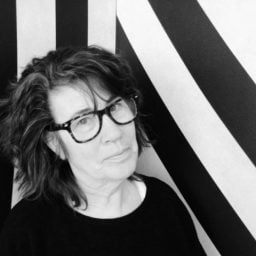Artists
‘I Am No Longer Anyone’s Model’: Celia Paul on Why She Chose Art Over Love
Painting comes before everything in her life—before family, friends, even food and sleep.
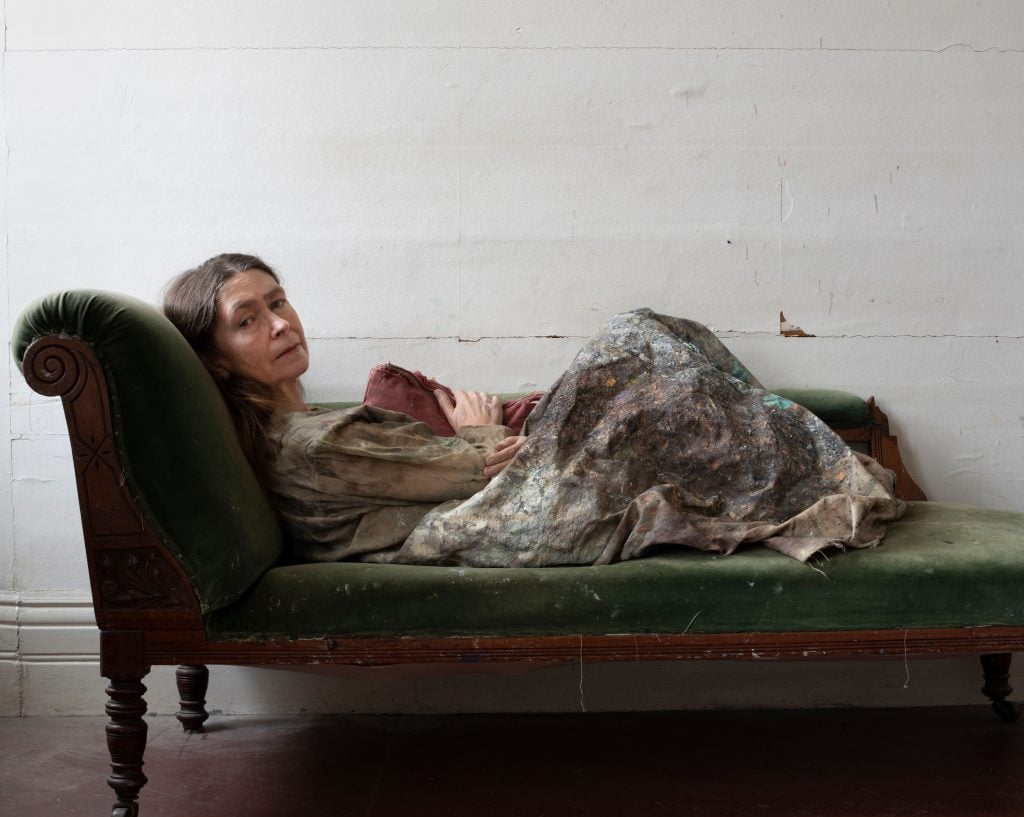
The British painter, Celia Paul, is an enigma. She is certainly soft spoken and shy, but under that is a fierce power that is at first unexpected, but then, as you get to know her, unsurprising. First and foremost, she lives to paint. Painting comes before everything in her life—before family, friends, even food and sleep.
When she paints, she moves into a hypnotic state and becomes what she is painting. Whether it is her four sisters, a vase of flowers, or the sea, she is at one with it all. She gets inside the work until canvas and subject merge and even she disappears. Perhaps that is why there is no mistaking a Celia Paul painting: the layers of paint, the muted tones, the Payne’s grey of dreams, the portraits with internal faces.
Last month, I reviewed her solo exhibit, “Life Painting” at Vielmetter Gallery in L.A. for the Observer. The show, which runs through March 9, 2024, includes 16 paintings illustrating Paul’s intense stillness and focus. Speaking with her about that exhibit, first in phone calls and then long emails, I expressed how getting older can ignite a sense of urgency, of needing more time as the work builds and blossoms. (Now age 64, Paul famously was in a relationship with fellow painter Lucian Freud from the age of 18 to 28, and had a child with him.) The interview below, edited for length, is from those conversations.
Do you ever feel you gave away your power to men in your youth, as I have done (even though we both have had success in our careers)?
I really hope this doesn’t sound arrogant, but I never felt I gave my power away to men in my youth. I just turned it inwards. I have been painting nearly every day of my life since the age of 15 and the daily discipline of my practice hasn’t wavered. The thing that has changed is that now I feel more supported and valued. Throughout the years of my involvement with Lucian, and through the years of motherhood, my art had the central place in my life. I just had to be very rigorous and ruthless about my time, and my painting space.
Women are in demand as carers—both for their partners, and for their children. The act of caring can be very fulfilling. My difficulty has always been a clash between love and art: in my experience, it’s impossible to do both at the same time. In practice, this means working in solitude. My art requires silence. I need time alone to plan my paintings. My best paintings come about through distillation: the image has to crystallize in my mind before I start. I don’t make high-speed gestural paintings.
In your self-portraits, do you look in a mirror or work from a photograph? I’m taken by the vulnerability you portray as well as inner strength. Your delicacy comes through in Painter Seated in her Studio. The way your feet are crossed, a hand holding the other on your lap. You are erect and ready but not aggressive in any way. It’s such a statement of who you are and how you want to be perceived.
When I first started painting self-portraits, I used to rely on mirrors. The results were often lifeless. After some years of failing to make a convincing self-portrait, I began looking in the mirror in order to get the basic structure of my face, then turned away and dreamt up the image of myself. The dream image was more psychologically true than the image made from direct observation. Most recently, I have used photographs of myself as references. I don’t copy from photographs, they act as springboards to greater freedom in self-representation.
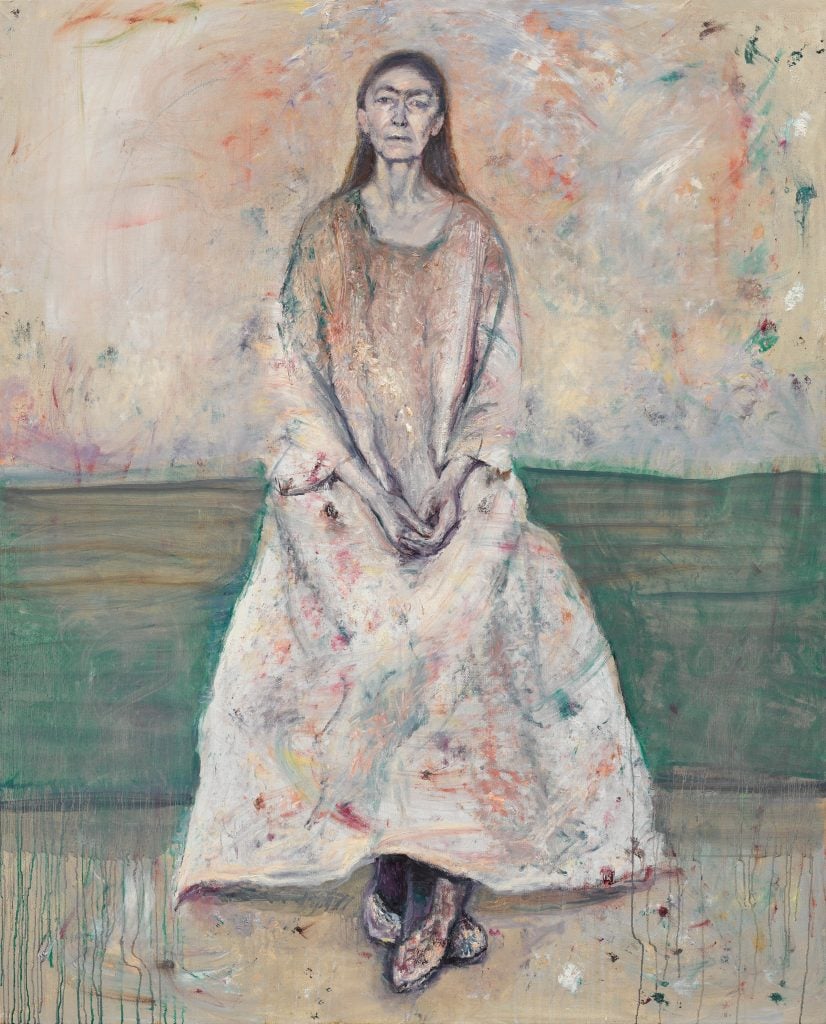
Celia Paul, Painter Seated in her Studio, (2023). © Celia Paul, Courtesy the artist and Victoria Miro
To be a great model, you have to give yourself up to the experience. You are “there” for the artist to do what they want with you. In my painting Model, I have used a photograph of Gwen John posing for Rodin as a template for the head, and the body is dreamt up by me. The naked figure has her arms raised in a cruciform. I wanted to show the woman’s absolute vulnerability, but her shoulders are powerful and her stance conveys defiance. Even when Gwen John was most infatuated with Rodin, she continued to paint. She depicted herself in a state of supplication and waiting. By confronting her vulnerability, she subtly subverted her passivity. I think I am doing something similar.
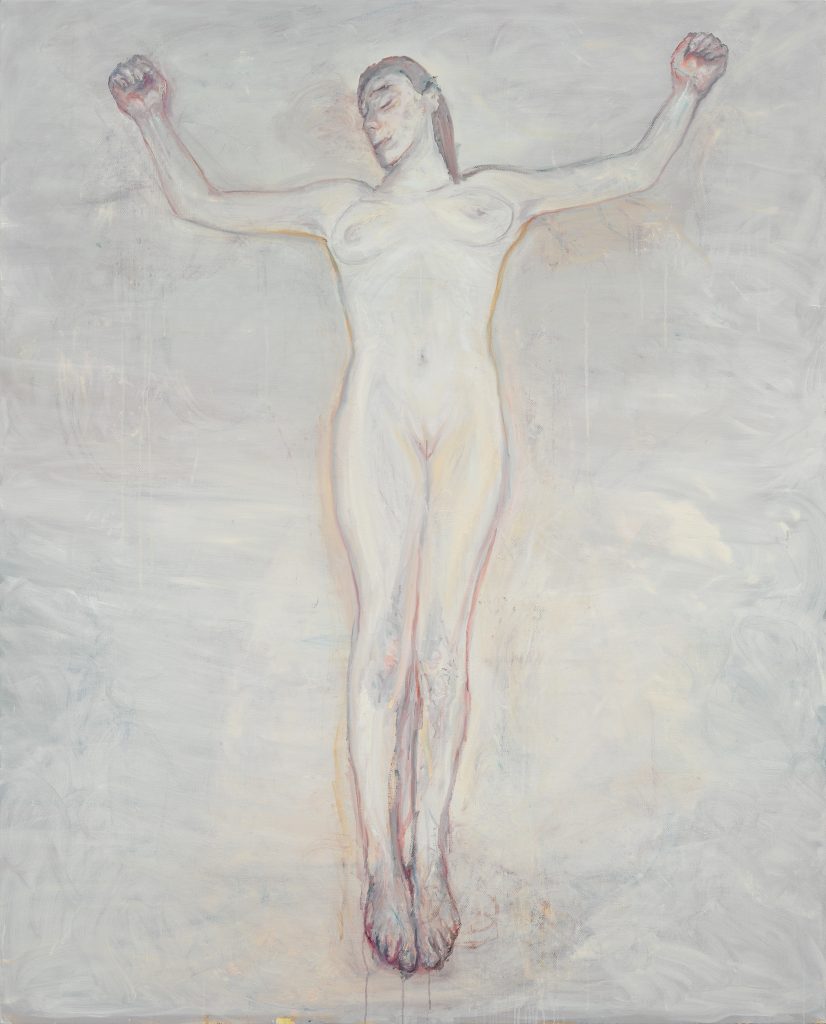
Celia Paul, Model, (2023). © Celia Paul, Courtesy the artist and Victoria Miro
Can you speak about the materials you use, your studio, and your routine for painting?
I like my colors to glow, and the light to accumulate from subdued to a veiled brightness. Some Goya portraits have the sort of luminescence I am after—the hazy light surfacing from the dark. I usually use a rough grained canvas; the weft and warp of the canvas are almost like lines on a musical score. I also work on very smooth canvas. The canvas doesn’t absorb the paint, so the marks and drips have an immediacy. I use a thin sable brush when working directly from life. After the model has gone, I rework the image using my hands, or paint rags or sponges, so that a more mysterious, less controlled image is freed. My best portraits come about from a mixture of direct observation and then a reinvention where I allow chance to take over.
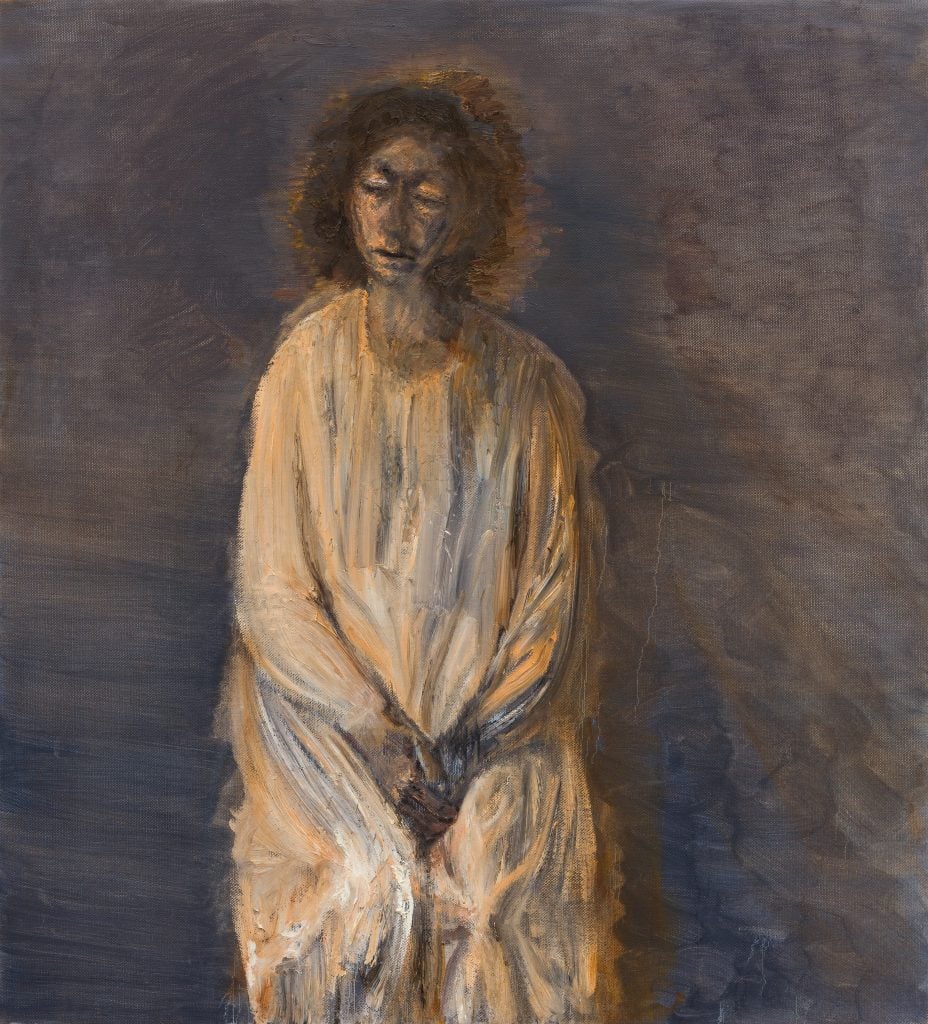
Celia Paul, Kate in White, Firelight 2018-2019 . © Celia Paul, Courtesy the artist and Victoria Miro
I have the most energy first thing in the morning. I wake very early, usually around 5 a.m. After one or two cups of tea, I begin painting. I start to flag around 1 p.m., then rest and read for a few hours. When I go back into the studio, I can get a clearer sense of whether the morning’s painting was successful or not. Because my studio is also where I live, it’s difficult to say how many hours a day I paint. Often, I get up in the middle of the night to carry on painting.
The studio where I live is situated directly opposite the main gates of the British Museum—a constant presence. I am high up, on a level with the classical stone figures carved into the triangular top of the pediment of the museum. Virginia Woolf was impelled to write A Room of One’s Own while in the Reading Room of the British Museum. Her anger was fueled by the lack of female representation in the books on the shelves. Inspired by that essay, I want my paintings to be an intimate contrast to the imposing posturing of the Museum’s façade.
In the work Painter (2022), I can clearly see a response to Lucian’s last painting of you, Painter and Model (1986/87).
Yes, in his version, I am standing to the left of the canvas; a naked man with splayed legs is lying on a sofa in front of me. I am holding a paintbrush which is angled at the man’s genitals, and my bare foot is standing on a tube of paint which is ejaculating a squirt of green pigment. My clasped hands holding the brush throw a breast-like shadow on the floor. I am self-contained compared to the man’s open availability. This was Lucian’s goodbye painting. I had chosen art, not love.
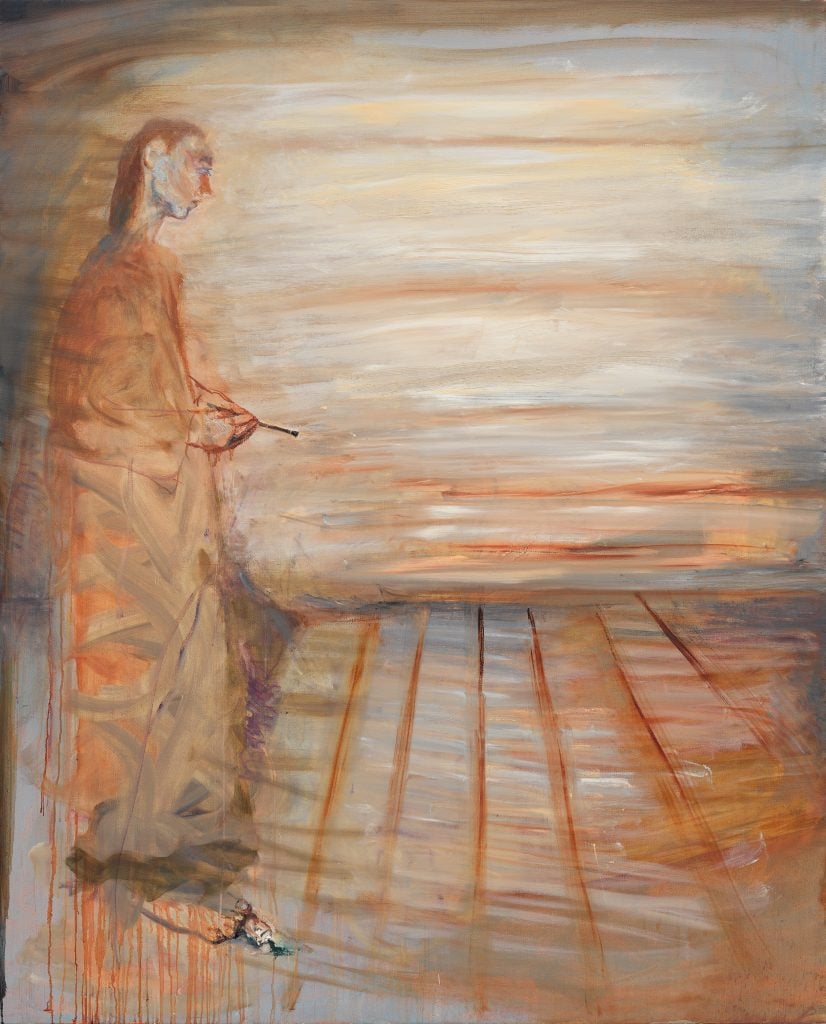
Celia Paul, Painter, 2022 . © Celia Paul, Courtesy the artist and Victoria Miro
The year after Lucian died, I painted my response to Freud’s painting which I also titled Painter and Model (2012). Then in 2022, I removed the “model.” I am no longer anyone’s model. I have depicted myself standing to the left of the canvas. I am holding a paintbrush and my bare foot is standing on a squeezed-out paint tube. But I have erased the man. In his place is a sea-like absence. This is a stark representation of the solitude of my practice.
Who are your influences? Who are your favorite painters and writers?
The painters I grew up with are the artists that form the nucleus of the so-called “School of London”: Lucian Freud, Francis Bacon, Frank Auerbach, Michael Andrews, and Leon Kossoff. These are the painters who have had the most direct influence on my working practice. I knew all of them personally to a greater or lesser extent. Their rigorous work routine, the importance of literature and philosophical thought, have inspired me in self-discipline and self-questioning. They are all, in different ways, great spiritual painters.
There are a lot of painters from the past who I think about all the time: Van Gogh, Rembrandt, Monet, Frans Hals, Turner, Constable, Giotto, Gwen John, Cezanne. The two artists alive today who mean the most to me are Frank Auerbach and Vija Celmins—they are the most subtle and spiritual artists. I have a lot to learn from them: the power and silence in their work.
The contemporary writers that I admire most are Kazuo Ishiguro and Yijun Li for the precision and beauty of their language, their emotional control. The writer who means most to me is Marcel Proust for the beauty, humor, vulnerability, love, the yearning in his work. I have read the whole of In Search of Lost Time several times. His writing feels like the company of a friend.
Those writers and artists are so much like who you are: tender, disciplined/controlled, strong, and vulnerable. What was it like to be with all those famous male artists at such a young age?
Lucian and I used to meet up regularly with Frank Auerbach and his wife Julia. We’d go to Wheelers or most often the Connaught Hotel. More informally, we met at Julia’s house in Islington. Julia was a wonderful cook. The two men dominated the conversation. Julia and I remained mostly silent. The longer I stayed silent, the more difficult it became to find my voice. So that when Frank asked “What do you think, Celia?” I would often be unable to speak.
Lucian and I dined on several occasions with Francis Bacon and his boyfriend John Edwards. The conversation between Lucian and Francis was mainly gossip. They didn’t discuss art or literature. Again, I was excluded from the conversation, this time because the three men shared anecdotes about people I didn’t know.
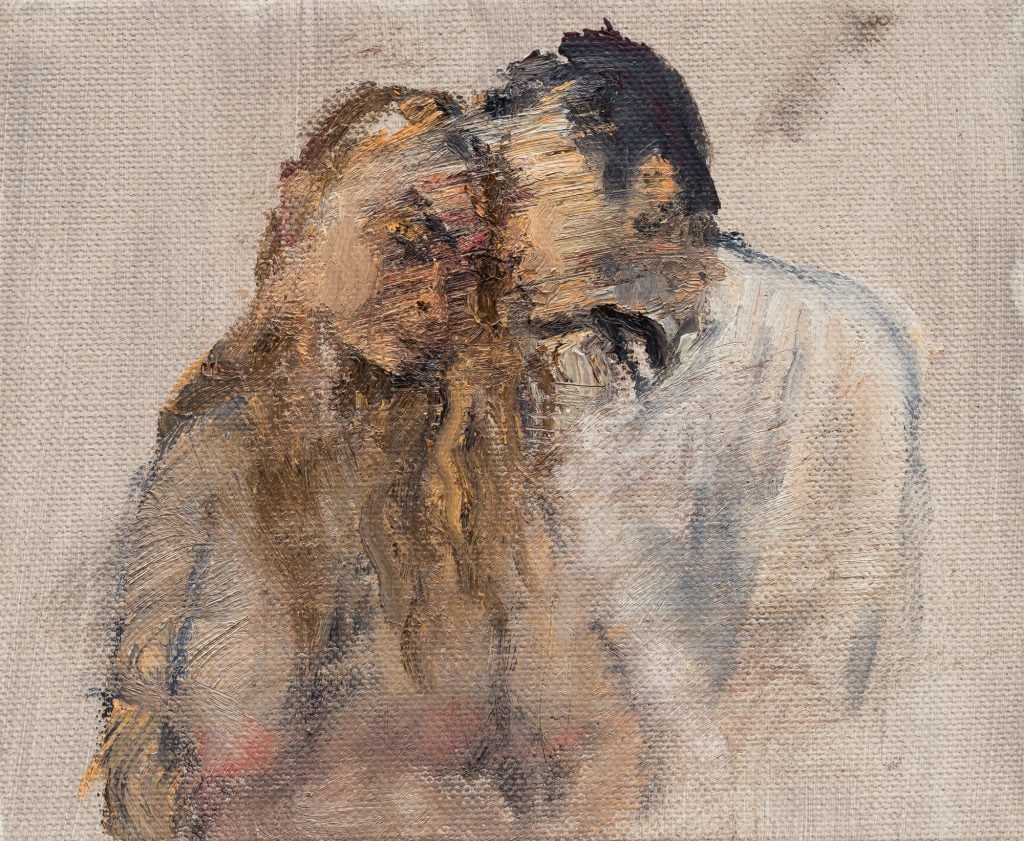
Celia Paul, Lucian and Me, (2019). © Celia Paul. Courtesy the artist and Victoria Miro
I was interested in seeing how Francis lived. His mews house was small: a tiny kitchen adjoined a long narrow sitting room (almost like a ship’s cabin); the room opposite was the studio. The furniture in the sitting room remained free of paint. I wondered how Francis managed to contain the explosion of paint that hit you as the studio door opened.
Leon Kossoff was always kind to me. Leon told me how much he admired my art, especially the portraits of my mother. He had a beautiful humorous expression in his eyes, and was often wryly funny.
These artist’s social personas were intimidating. Their attitude to women would be shocking to any educated person now. Yet they have shaped my destiny. And they are all great artists.
Can you speak about your paintings of the sea and of flowers—and especially the portraits of your mother that I find so deeply touching?
The sea is a symbol of movement and stillness—the water constantly shifting, always in flux, yet contained, controlled. By thinking about water and waves, my inner weather can find a resonance. My flower paintings are almost always about renewal. My favorites are roses and peonies, the infolding, the lushness combined with discreteness, the heavenly scent. I want to convey their exquisite perfume with my paint-marks.
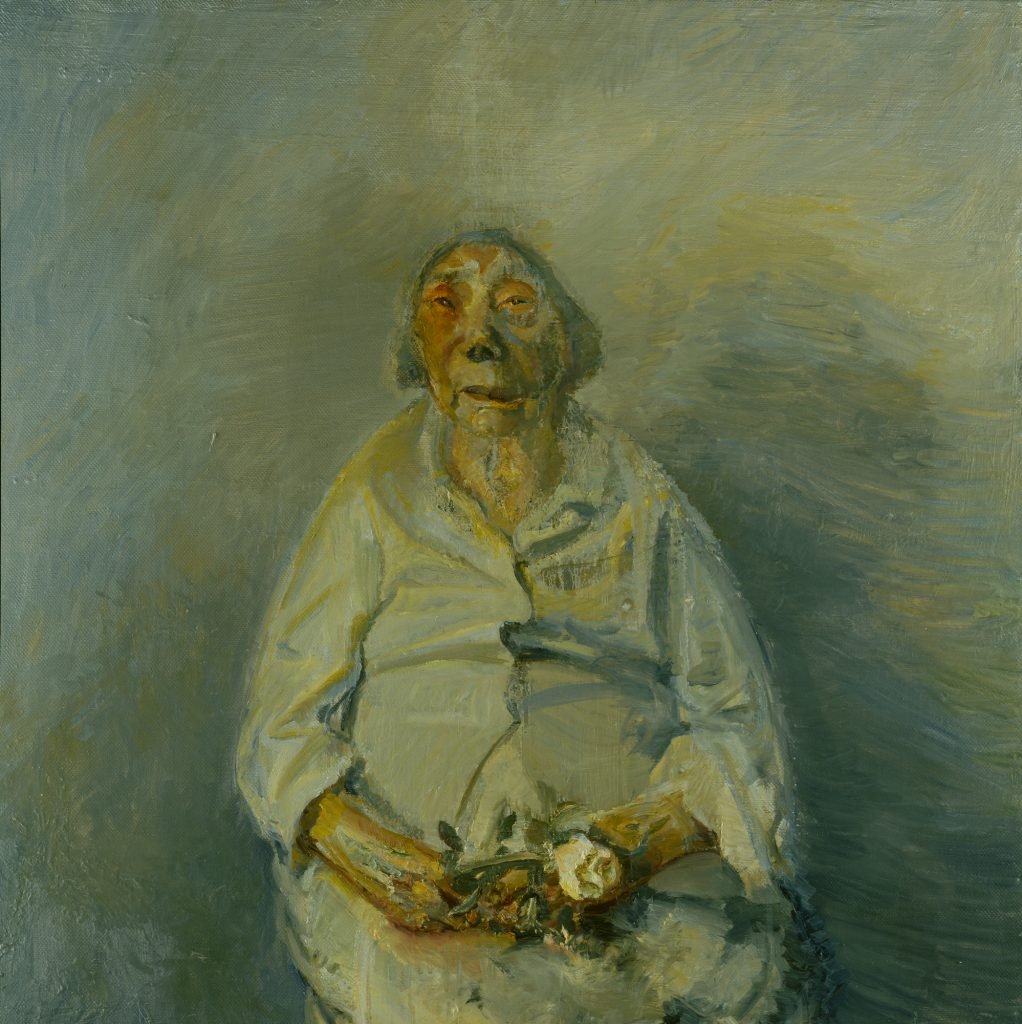
Celia Paul, My Mother with a Rose, 2006. © Celia Paul, Courtesy the artist and Victoria Miro
I miss my mother every day. She died in 2015. For 30 years, from 1977 to 2007, she sat for me twice a week. The act of sitting was an act of devotion. She wasn’t interested in the outcome; she was “there” for me. I think prayer is the equivalent of this form of attention, of being present. In this sense, I pray, especially when I paint, because my attention is what will give the painting a chance of having a life of its own. Every artist wants to create a work of art that has a life of its own, separate from its maker.
What’s next for you?
I will be showing in the inaugural exhibition of FAMM/Female Artists of the Mougins Museum, in the south of France, as part of Christian Levett’s collection, opening June 21. A big monograph of my paintings spanning 50 years is going to come out in Spring 2025, published by Mack Publishing. It will contain essays by Karl Ove Knausgaard, Hilton Als, Clare Carlisle, Rowan Williams, Edmund de Waal, and a short text by me. To coincide with the publication, I will have a big exhibition at Victoria Miro London, in Spring 2025. I am going to need to focus on producing a large body of new work for this exhibition.
And do you have any regrets?
I have no regrets.

